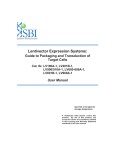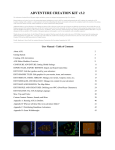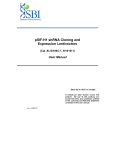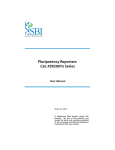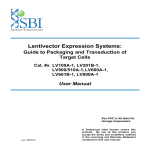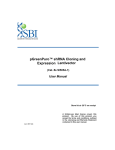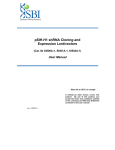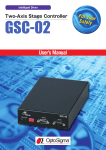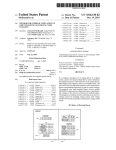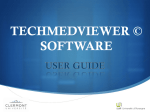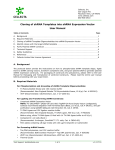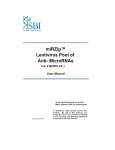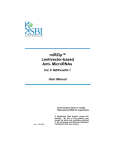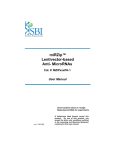Download User Manual - System Biosciences
Transcript
Double-Promoter pFIV-H1/U6 siRNA Cloning and Expression Vectors (Cat. # SI110A-1; SI111A-1) User Manual Store kit at -20°C on receipt (Ver. 2-041015) A limited-use label license covers this product. By use of this product, you accept the terms and conditions outlined in the Licensing and Warranty Statement contained in this user manual. Double-Promoter pFIV-H1/U6 siRNA Vectors Cat. # SI110A-1, SI111A-1 Contents I. Introduction and Background A. B. C. D. E. F. G. Overview siRNA Technology FIV Lentiviral Expression System Double-Promoter pFIV siRNA Transduction Vectors List of Components Additional Required Materials Safety Guidelines 2 2 2 3 6 6 8 II. Protocol A. siRNA Oligonucleotide Design and Synthesis B. Cloning of siRNA Template into pFIV-H1/U6 Vector C. Identify Clones with siRNA Inserts D. Transfection and Analysis of Silencing Efficiency 9 10 11 14 III. Troubleshooting A. Using the Positive Control B. Troubleshooting Specific Results IV. References 15 15 17 V. Appendix A. Features and Maps for pFIV-H1/U6 Vectors B. Properties of copGFP Fluorescent Protein C. Related Products D. Useful Oligonucleotide Conversions E. Technical Support VI. Licensing and Warranty Statement 888-266-5066 (Toll Free) 650-968-2200 (outside US) 20 24 24 25 25 26 Page 1 System Biosciences (SBI) User Manual I. Introduction and Background A. Overview This manual provides details and information necessary to clone an siRNA template into the double-promoter pFIV-H1/U6 siRNA Cloning and Expression Vectors (pFIV-H1/U6-Puro™ and pFIV-H1/U6-copGFP™ Vectors). Specifically, it provides critical instructions on designing and synthesizing siRNA templates, cloning the siRNA templates into the pFIVH1/U6 Vectors, and confirming successful cloning. This manual does not include information on packaging pFIV-H1/U6 Vector constructs into pseudoviral particles or transducing your target cells of choice with these particles. This information is available in the user manual provided with the pFIV Lentiviral Vector Packaging Kit from SBI (Cat. # LV100A-1), which is available on the SBI web site (www.systembio.com). Before using the reagents and material supplied with this system, please read the entire manual. B. siRNA Technology Short double-stranded RNAs with sizes 19-29 bp can efficiently mediate gene silencing in mammalian cells by guiding sequence-specific degradation of target mRNA sequences (Bernstein 2001, Hammond 2000). Synthetic double-stranded siRNA molecules can be introduced into cells to suppress gene expression transiently. Alternatively, siRNA templates can be cloned into an siRNA expression vector—such as SBI’s pFIV™ Series of siRNA Cloning and Expression Vectors—and expressed in the cells of choice. Endogenously expressed siRNA effectors provide long-term silencing of the target gene and allow the researcher to generate cell lines and transgenic organisms with a stable knockdown phenotype for functional studies. Two approaches have been developed for in vivo expression of siRNAs from plasmid and viral vectors. In one approach, the sense and anti-sense strands are transcribed separately from two independent promoters and form the siRNA duplex (Lee 2002, Miyagishi 2002). With the second approach, a single-stranded siRNA sequence with a fold-back stem-loop structure (also known as a “hairpin”) is expressed from a single promoter. This sequence is then converted into double-stranded siRNA after intracellular processing cleaves the loop (Brummelkamp 2002, Paddison 2002). In both approaches, the siRNA molecules are transcribed from constitutive RNA polymerase III promoters (i.e., U6 and/or H1) and terminated with TTTTT (T5) sequences (Tuschl 2002). The U6 and H1 promoters are different in size but contain the same conserved sequence elements (Myslinski 2001). C. FIV Lentiviral siRNA Expression System Lentiviral expression vectors are the most effective vehicles for delivering genetic material to almost any mammalian cell—including non-dividing cells and whole model organisms. As with standard plasmid vectors, it is possible to introduce lentiviral siRNA constructs in plasmid form into the cells with low-to-medium efficiency using conventional transfection protocols. However, by packaging the lentiviral siRNA vector construct in viral particles, you can obtain highly efficient transduction and heritable expression of siRNA—even with most difficult to transfect cells, like primary, stem, and differentiated cells. Page 2 ver. 2-041015 www.systembio.com Double-Promoter pFIV-H1/U6 siRNA Vectors Cat. # SI110A-1, SI111A-1 The lentiviral siRNA expression system consists of three main components: (1) The lentiviral expression vector (2) The lentiviral packaging vector (3) A packaging cell line The lentiviral expression vector contains the genetic elements responsible for packaging, transduction, stable integration of the viral expression construct into genomic DNA, and expression of the siRNA effector sequence. The packaging vector provides all the proteins essential for transcription and packaging of an RNA copy of the expression construct into recombinant viral particles. To produce a high titer of viral particles, transiently co-transfect packaging cells (e.g., HEK 293 cells) with the expression and packaging vectors. The most popular lentiviral expression system is HIV based (Abbas-Terki 2002, Qin 2003, Wiznerowicz 2003). In spite of improved biosafety features, third generation HIV cloning vectors still pose a slight biohazard risk due to possible recombination with endogenous viral sequences to form a self-replicating HIV virus. SBI’s novel pFIV siRNA Vectors address these issues since they are derived from feline immunodeficiency virus (FIV; Poeschla, 2003; for Safety Guidelines when working with these vectors, see section G). In addition, the pFIV Vectors developed at SBI are self-inactivating as a result of a deletion in the U3 region of 3’∆LTR (see Appendix for Vector Features). Upon integration into the genome, the 5’ LTR promoter is inactivated, which prevents formation of replication-competent viral particles. When expressed, the hybrid CMV/FIV 5’ LTR drives high level transcription of the viral construct and produces a transcript that contains all the necessary functional elements (i.e., Psi, RRE, and cPPT) for efficient packaging. When this construct is expressed in HEK 293 cells that also express viral coat proteins (i.e., a packaging cell line), the pFIV transcripts are efficiently packaged into pseudoviral particles. After isolation, these pseudoviral particles containing the RNA version of the pFIV expression cassette can be efficiently transduced into any mammalian target cells. Following transduction into the target cells, this expression cassette is reverse transcribed and integrated into the genome of the target cell. The pFIVH1/U6 Vectors also contain a bacterial origin of replication and ampicillin resistance (AmpR) gene for propagation and selection in E. coli. The pFIV-H1/U6-Puro Vector (Cat. # SI110A-1) contains a puromycin resistance gene, under the control of a constitutive CMV promoter and a WPRE regulatory element, to enable selection of target cells stably expressing the siRNA template. The pFIV-H1/U6-copGFP Vector (Cat. # SI111A-1) contains a copGFP reporter gene under the CMV promoter and WPRE element. CopGFP is a novel fluorescent protein, derived from copepod plankton (Panalina sp.), which is similar to EGFP but has a brighter color. D. Double-Promoter pFIV siRNA Vectors The unique double-promoter lentiviral pFIV-H1/U6 siRNA Cloning Vectors contain opposing modified RNA polymerase III promoters (H1 and U6) that flank the siRNA template (Fig. 1). The pFIV-H1/U6 Vectors already have terminator sequences (T5) just upstream of the transcriptional start sites (see Figs. 1 and 2). After transcription, the resulting ds siRNA product has the same structure as “natural” double-stranded siRNA and does not require the “dicer” processing step—as is the case with short-hairpin RNA (also known as shRNA). The 888-266-5066 (Toll Free) 650-968-2200 (outside US) Page 3 System Biosciences (SBI) User Manual double-promoter pFIV-H1/U6 Vectors also provide higher stability of siRNA template inserts during propagation in E. coli because it does not contain a hairpin structure that is often removed during bacterial replication. This increased stability is very critical for construction of representative high complexity siRNA libraries. In addition, shorter siRNA sequences are less costly to produce and are easier to clone. These advantages make the double-promoter pFIV-H1/U6 siRNA Vectors highly suitable for siRNA library construction, as well as convenient for cloning and expressing single siRNA sequences. The pFIV-H1/U6 Cloning Vectors are provided in a ready-to-ligate linearized form that has been digested with BbsI, and purified to remove the stuffer fragment. The linearized vector contains two unique 5’ overhangs to facilitate directional cloning with minimal self-ligation background (Fig. 1). Two PCR primers that flank the H1 and U6 promoter regions are included to provide a simple way to screen plasmid clones for the presence of siRNA inserts (Fig. 2). Fig. 1. Design of double-promoter siRNA cassette and siRNA template oligos. The dotted lines in the middle of the figure indicate the position of the “stuffer fragment” that was removed by digesting the vector with BbsI. A BamHI site, which is useful in screening (see Fig. 2), is located in the stuffer fragment. The transcriptional start site is indicated by the arrows denoted +1. The T5 transcription terminators are also indicated. On the bottom of the figure, an example of the sequence for the p53 siRNA template oligonucleotides is shown. Page 4 ver. 2-041015 www.systembio.com Double-Promoter pFIV-H1/U6 siRNA Vectors Cat. # SI110A-1, SI111A-1 Fig. 2. Transcription of the p53 example construct from a double-promoter pFIV-H1/U6 Vector. Transcription of the p53 siRNA template starts at the indicated arrows and occurs simultaneously from both the H1 and U6 promoters. The structure of the p53 siRNA molecule is shown. Also shown is the location of the H1 and U6 PCR primers. Amplification with these primers spans the cloning site and produces a 163 bp PCR product for the p53 siRNA sequence shown. The size of the product is similar for both positive and negative clones because of the similarity in sizes of the insert and the stuffer fragment. When screening for inserts, the absence of the BamHI site (see Fig. 1) indicates a positive clone. 888-266-5066 (Toll Free) 650-968-2200 (outside US) Page 5 System Biosciences (SBI) User Manual E. List of Components Each pFIV-H1/ Vector Kit provides enough plasmid for 20 ligation reactions: • pFIV-H1/U6-Puro™ siRNA Cloning and Expression Vector (Cat. # SI110A-1) 50 µl 25 µl 25 µl 25 µl • pFIV-H1/U6-Puro™ vector (linearized, 20 ng/µl) Luciferase Control siRNA Oligonucleotide (annealed; 100 ng/µl) H1 PCR primer (5’-CTGGGAAATCACCATAAACGTGAA-3’; 10 µM) U6 PCR primer (5’-GCTTACCGTAACTTGAAAGTATTTCG-3’; 10 µM) pFIV-H1/U6-copGFP™ siRNA Cloning and Expression Vector (Cat. # SI111A-1) 50 µl 25 µl 25 µl 25 µl pFIV-H1/U6-copGFP™ vector (linearized, 20 ng/µl) Luciferase Control siRNA Oligonucleotide (annealed; 100 ng/µl) H1 PCR primer (5’-CTGGGAAATCACCATAAACGTGAA-3’; 10 µM) U6 PCR primer (5’-GCTTACCGTAACTTGAAAGTATTTCG-3’; 10 µM) The kits are shipped in dry ice and should be stored at -20°C upon receipt. Properly stored kits are stable for 12 months from the date received. F. Additional Required Materials For Annealing siRNA Oligonucleotides • 2X DNA Annealing Buffer (20mM Tris, pH 7.8; 100mM NaCl; 0.2mM EDTA) For Phosphorylation of Annealed siRNA Oligonucleotides • T4 Polynucleotide Kinase (Recommended: New England BioLabs T4 Polynucleotide Kinase, Cat. # M0201S) For Ligating and Transforming siRNA Vector Construct • T4 DNA Ligase and ligation reaction buffer (Recommended: New England BioLabs T4 DNA Ligase, Cat. # M0202S. Dilute to 5 U/µl with the provided 1X reaction buffer just before use) • Competent E. coli cells (RecA ) (Recommended: BDB Clontech Fusion-Blue™ competent cells, Cat. # 636700) • Petri plates containing LB Agar media with 50 µg/ml Ampicillin For Screening siRNA Inserts • Taq DNA polymerase, reaction buffer, and dNTP mix (Recommended: BDB Clontech Titanium™ Taq DNA polymerase, Cat. # 639208) • PCR machine • BamHI enzyme (New England BioLabs, Cat. # R0136M) • 2-3% 1X TAE Agarose gel Page 6 ver. 2-041015 www.systembio.com Double-Promoter pFIV-H1/U6 siRNA Vectors Cat. # SI110A-1, SI111A-1 For Purifying siRNA Vectors after Cloning • Plasmid purification kit (Recommended: QIAGEN Endotoxin-free Plasmid Kit. The following kit combinations can be used for Midi scale preparation of endotoxin-free DNA: ¾ QIAfilter Plasmid Midi Kit, Cat. # 12243, and EndoFree Plasmid Maxi Kit, Cat. # 12362 ¾ QIAfilter Plasmid Midi Kit, Cat. # 12243, and EndoFree Plasmid Buffer Set, Cat. # 19048 Please visit the QIAGEN website to download the specialized protocol that is not contained in the user manual: ¾ http://www1.qiagen.com/literature/protocols/pdf/QP15.pdf 888-266-5066 (Toll Free) 650-968-2200 (outside US) Page 7 System Biosciences (SBI) User Manual G. Safety Guidelines The feline immunodeficiency virus (FIV) was originally isolated from cat blood. Despite common close exposure of humans to FIV through contact with domestic cats (including bites, scratches, etc.), no human infection or disease has ever been associated with FIV (Poeschla, 2003). Work with FIV-based viruses falls within NIH Biosafety Level 2 criteria. For a detailed description of laboratory biosafety level criteria, consult the following pages on the Centers for Disease Control Office of Health and Safety Web site: http://www.cdc.gov/od/ohs/biosfty/bmbl4/bmbl4s3.htm http://www.cdc.gov/od/ohs/biosfty/bmbl4/bmbl4toc.htm Also, you should consult the health and safety guidelines and officers at your institution regarding use and handling of the FIV lentiviral system. In addition, although the system itself has been designed to minimize possible risk, specific recombinant FIV vector constructs may be potentially hazardous, depending on the nature of introduced insert (such as oncogenes, toxins, siRNA to tumor suppressor genes, etc.). For these reasons, it is critical to exercise due caution while working with recombinant lentiviruses. To ensure safe laboratory handling, you should thoroughly understand the biology of the lentiviral vectors and the specific modifications and design features of the SBI system with which you are working. The original FIV viral vector was developed by Eric M. Poeschla, David J. Looney, and Flossie Wong-Staal in UCSD (Poeschla 2003). Based on this original FIV vector, the pFIV-H1/U6 Vectors for cloning and expressing siRNA were developed at SBI. These vectors have been modified to remove sequences that overlap with the packaging plasmid to minimize the possibility for homologous recombination and generation of self-replicating viral sequences when co-transfecting these constructs into packaging cells. SBI’s pFIV-H1/U6 vectors also have a deletion in the enhancer of the U3 region of 3’ ∆LTR to ensure self-inactivation of the lentiviral vector after transduction and integration of the sequences into the genomic DNA of the target cells. To avoid any possible contamination and maintain a clean laboratory environment we also recommend following these standard safety practices: • Wear double gloves, face protection, and lab coat at all times. • Perform work in a limited access area in a Biological Safety Cabinet Class II and post biohazard warning signs. • Minimize splashes or aerosols with careful pipetting. • Take precautions with needles, blades, etc. • Decontaminate work surfaces at least once a day and after any spill of viable material. • Decontaminate all cultures, stocks, and other biological wastes before disposal using approved decontamination methods, such as autoclaving. Before decontamination the biological materials should be placed in a sealed, durable, leak-proof container for transport from the laboratory. Page 8 ver. 2-041015 www.systembio.com Double-Promoter pFIV-H1/U6 siRNA Vectors Cat. # SI110A-1, SI111A-1 II. Protocol A. siRNA Oligonucleotide Design and Synthesis Typically, 4 or 5 target sequences in the gene of interest need to be selected and tested to identify functional siRNA oligonucleotides with at least 70% silencing efficiency of target mRNA. Although, there is no standard rule for selecting the target binding sites for siRNA sequences, we have found the following criteria useful: • 19-29 nt in length (usually longer oligos (25-27 nt) have slightly better silencing efficiencies although 19 nt oligos are more commonly used). • Unique sequence (< 70% Homology with other sequences in a RefSeq database). • 40%-50% GC content. • No more than 4 consecutive A’s or T’s. • No more than 5 consecutive G’s or C’s. • No thermodynamically stable secondary structure (< 0 Kcal/mol). • A 5’-terminus on the anti-sense strand that is more AT-rich than the 3’-terminus. For each selected sequence, two complementary siRNA oligonucleotides (a sense strand and an anti-sense strand) need to be synthesized, then annealed before the phosphorylation and ligation steps. Below are guidelines for synthesis of the siRNA template oligonucleotides: (1) A 50 nmol scale reaction for DNA oligonucleotide synthesis with regular desalting purification is sufficient for cloning into the pFIV Vectors. (2) For the best cloning efficiency, we recommend using phosphorylated oligonucleotides which can typically be ordered from the supplier. Alternatively, you can phosphorylate the oligonucleotides after synthesis using T4 polynucleotide kinase. The phosphorylation procedure is shown below in step B.2. (3) In addition to the sense or anti-sense siRNA sequence the oligonucleotide needs to include a 4-base sequence at the 5’ end of each oligonucleotide (AAAG on sense strand and AAAA on the anti-sense strand). These sequences form “sticky-ends” that facilitate ligation with the BbsI-digested vector. The annealed sequences should have a doublestranded siRNA structure as shown in the following diagram (See also Fig. 1). Sense (top) 5’- AAAGNNNNNNNNNNNNNNNNNNN -3’ 3’NNNNNNNNNNNNNNNNNNNAAAA -5’ Anti-sense (bottom) 888-266-5066 (Toll Free) 650-968-2200 (outside US) Page 9 System Biosciences (SBI) User Manual B. Cloning of siRNA Template into pFIV-H1/U6 Vector 1. Anneal siRNA Oligonucleotides a. Dissolve the siRNA oligonucleotides in an appropriate amount of deionized water to a final concentration of 1 µg/µl. Prepare the ds siRNA oligonucleotide as follows: b. 2.5 2.5 25.0 20.0 50.0 µl µl µl µl µl Sense strand siRNA oligonucleotide Anti-sense strand siRNA oligonucleotide 2X Annealing Buffer Deionized water Total volume c. d. Heat the mixture to 95°C for 5 min in a thermocycler or heating block. Turn off the thermocycler or heating block and let it cool to room temperature. e. The annealed oligonucleotide (100 ng/µl) is ready for phosphorylation and ligation steps. Store the annealed oligonucleotides at -20°C until use. 2. Phosphorylate the Template siRNA Note: If your oligonucleotides are already phosphorylated, dilute them to 10 ng/µl in 1X Annealing Buffer, skip this phosphorylation step, and proceed to ligation in step 3. However, you must phosphorylate the Luciferase Control Oligonucleotide before continuing with step 3. For the insertminus control, you may either follow step 2 or use 1 µl Annealing Buffer in step 3. Set up 10 µl phosphorylation reactions for each experimental siRNA template as follows: a. 1 1 1 6 1 10 µl µl µl µl µl µl Annealed ds siRNA template oligos (100 ng/µl) * 10X T4 Polynucleotide Kinase Buffer 10 mM ATP Deionized water T4 Polynucleotide Kinase (10 U/µl) Total volume * For the insert-minus control, use 1 µl 1X Annealing Buffer For the positive control, use 1 µl of the Luciferase Control Oligonucleotide. b. Incubate the phosphorylation reaction at 37°C for 30 minutes. To stop the reaction, heat at 70°C for 10 min. c. Use 1 µl (10 ng) for the following ligation reaction. Page 10 ver. 2-041015 www.systembio.com Double-Promoter pFIV-H1/U6 siRNA Vectors 3. Cat. # SI110A-1, SI111A-1 Ligate the Template siRNA a. Set up 10 µl ligation reactions for each phosphorylated siRNA template as follows: 2.5 1.0 1.0 4.5 1.0 10.0 µl µl µl µl µl µl Linearized pFIV-H1/U6 Vector (20 ng/µl) Phosphorylated ds siRNA template (step 2; 10 ng/µl) ** 10X T4 DNA Ligase Buffer Deionized water T4 DNA ligase (5 U/µl) Total volume ** For controls, use insert-minus and positive control from step 2. b. 4. Incubate the ligation reaction at 16°C for 2-4 hrs. Transform E. coli with the ligation product a. b. c. For each experimental siRNA template, use the whole volume of ligation product for transformation. Follow the manufacturer’s protocol for transforming the competent cells. Plate an appropriate amount of cells on LB plates with 50 µg/ml ampicillin and grow overnight at 37°C. C. Identify clones with the target siRNA template 1. Prepare colony cultures a. Randomly pick up 10 well-separated colonies from each plate and grow each clone in 100 µl of LB Broth with 100 µg/ml ampicillin at 37°C for 2 hours with shaking. b. Take 1 µl of each bacteria culture for PCR screening (see C.2) and continue to grow the culture for another 6 hours. Store the bacterial culture at 4°C. c. 888-266-5066 (Toll Free) 650-968-2200 (outside US) Page 11 System Biosciences (SBI) 2. User Manual Screen for siRNA template inserts There are two options for insert screening. The first is screening using the H1 and U6 PCR primers provided in the kit followed by digestion of the PCR product by BamHI which is only present in negative clones. Alternatively, you can simply use your anti-sense strand siRNA oligo and U6 PCR primer (or sense strand siRNA oligo and H1 PCR primer) to amplify only positive clones. a. Prepare a PCR master mix for each clone you would like to screen for the presence of an siRNA template insert as follows: 1 rxn 0.5 µl 0.5 µl 0.5 µl 2.5 µl 19.5 µl 0.5 µl 24.0 µl 10 rxn 5 µl 5 µl 5 µl 25 µl 195 µl 5 µl 240 µl Composition H1 PCR primer (10 µM) U6 PCR primer (10 µM) 50X dNTP mix (10 mM of each) 10X PCR Reaction Buffer Deionized water Taq DNA polymerase (approx. 5 U/µl) Total volume b. Mix the master mix very well and aliquot 24 µl into each well of 96-well PCR plate or individual tubes. c. d. Add 1 µl of each bacterial culture from C.1 into each well or tube from C.2.b. Mix. Proceed with PCR using the following program: 94°C, 4 min 1 cycle 94°C, 0.5 min, then 68°C, 1 min 25 cycles 68°C, 3 min 1 cycle e. Dilute BamHI enzyme to 5 U/µl in 1X BamHI buffer. f. g. Take 15 µl of PCR product from step d and add 1 µl of diluted BamHI from step e. Mix. Incubate at 37°C for 30 min. h. Take 5 µl of the digestion reaction and run it on a 2-3% agarose/EtBr gel in 1X TAE buffer. PCR product from clones without an insert will be digested, resulting in two bands at 81 and 91 bp. Product from positive clones will not be digested, and the resulting band is 163 bp for 19 bp siRNA templates (see Fig. 2). Grow a positive clone in an appropriate amount of LB-Amp Broth, and purify the plasmid construct using an endotoxin-free plasmid purification kit (see Section I.F). Page 12 ver. 2-041015 www.systembio.com Double-Promoter pFIV-H1/U6 siRNA Vectors Cat. # SI110A-1, SI111A-1 2A. Screen for siRNA template inserts (Alternative Protocol) a. Prepare a PCR master mix for each clone you would like to screen for the presence of an siRNA template insert as follows: 1 rxn 0.5 µl 0.5 µl 0.5 µl 2.5 µl 19.5 µl 0.5 µl 24.0 µl 10 rxn 5 µl 5 µl 5 µl 25 µl 195 µl 5 µl 240 µl Composition U6 PCR primer (10 µM)* Anti-sense strand siRNA oligonucleotide (10 µM)* 50X dNTP mix (10 mM of each) 10X PCR Reaction Buffer Deionized water Taq DNA polymerase (approx. 5 U/µl) Total volume * Optional: To confirm the insert in the reverse direction, replace the first two components with the H1 PCR primer and the sense strand siRNA oligonucleotide. b. Mix the master mix very well and aliquot 24 µl into each well of 96-well PCR plate or individual tubes. c. d. Add 1 µl of each bacterial culture from C.1 into each well or tube from C.2.b. Mix. Proceed with PCR using the following program: 94°C, 4 min 1 cycle 94°C, 0.5 min, then 68°C, 1 min 25 cycles 68°C, 3 min 1 cycle e. Take 5 µl of PCR product from step d and run it on a 2-3% agarose/EtBr gel in 1X TAE buffer. Only those clones with a correct insert will amplify. For 19 bp siRNA templates, the expected size of amplified siRNA inserts should be 87 bp if using the U6 PCR primer and anti-sense strand siRNA oligo. If you are using the H1 PCR primer and sense strand oligo, the product should be 95 bp. Grow a positive clone in an appropriate amount of LB-Amp Broth, and purify the plasmid construct using an endotoxin-free plasmid purification kit (see Section I.F). 888-266-5066 (Toll Free) 650-968-2200 (outside US) Page 13 System Biosciences (SBI) User Manual D. Transfection and Analysis of Silencing Efficiency If you are planning to use SBI’s pFIV siRNA vectors for viral delivery, first screen the siRNA constructs generated in section C to determine their effectiveness at knocking down expression of the target gene of interest. To rapidly screen the lentiviral siRNA constructs in plasmid form, you can deliver and express them in HeLa or HEK 293 cells using chemical transfection. For example, with these cells the Lipofectamine™ Reagent (Invitrogen, Cat. # 18324-111) with Plus™ Reagent (Invitrogen, Cat. # 11514-015) system works well. Alternatively, you can use your target cells for this analysis. If you have already established a transfection method for your target cells, use your established conditions. If you do not have an established transfection protocol, we recommend you compare efficiencies of several transfection procedures (e.g., Invitrogen’s Lipofectamine™ 2000, Cat. # 11668-027, BDB Clontech’s CLONfectin™, Cat. # 631301). For siRNA knockdown studies using transfection, it is important to optimize the selected transfection protocol and then keep the parameters constant to ensure reproducible results. Depending on what is appropriate for your target gene, the silencing efficiency of different siRNA constructs can be estimated by determining the concentration of target mRNA using RT-PCR, assessing the amount of target protein by Western blot or ELISA, or assaying for activity of the target protein. Usually siRNA constructs with 70-80% silencing efficiency are suitable for gene functional analysis studies. Once you identify a functional siRNA construct, you can package this construct into FIV pseudoviral particles, and efficiently transduce it into any target cells of choice. For this purpose, you will need to purchase the pFIV-PACK™ Lentiviral Vector Packaging Kit from SBI (Cat. # LV100A-1) and HEK 293T cells (ATCC, Cat. # CRL-11268). The pFIV-PACK User Manual includes the procedural information for packaging the viral vector. This user manual is also available on the SBI web site (www.systembio.com). Although you can create stable transfectants with the pFIV construct using standard transfection and selection protocols, transduction of the lentiviral pFIV siRNA construct using packaged pseudoviral particles is the most efficient way to express siRNA in wide range of cells, including dividing, non-dividing, and hard-to-transfect varieties. Page 14 ver. 2-041015 www.systembio.com Double-Promoter pFIV-H1/U6 siRNA Vectors Cat. # SI110A-1, SI111A-1 III. Troubleshooting A. Using the Positive Control The Luciferase Control siRNA Oligonucleotide is a double stranded DNA fragment with sticky ends (5’AAAG, and 5’AAAA) to match with the BbsI-digested ends on the linearized pFIVH1/U6 vector. The 19-base siRNA template sequence targets the Luciferase gene. When run in parallel with your experimental annealed double-stranded siRNA oligonucleotides, Luciferase Control siRNA Oligonucleotide serves as positive control to check if your phosphorylation and ligation reactions and transformation procedure work well. Using the protocol described in II.B, ligation with this control insert should provide 2-10 times more colonies than ligation of the vector without an insert. The control pFIV construct with the Luciferase siRNA template can also be used to monitor the efficiency of target Luciferase mRNA silencing. A cell line with a constant expression level of Luciferase can easily be generated. The level of Luciferase expression should be reduced at least 5-fold after transfection or transduction of the pFIV-H1 Luciferase siRNA construct in the cell. B. Troubleshooting Specific Results 1. Getting Few or No Clones Check design of the siRNA template Check the sequence of the siRNA oligonucleotides to ensure that, after sense/anti-sense annealing, the ends present the 5’ AAAG and 5’ AAAA overhangs for proper annealing with the restricted ends of linear pFIV-H1/U6 Vector. Also, confirm that the sense and anti-sense strands sequences reverse complement each other. Check sense/anti-sense annealing To ensure a high percentage (80%) of double-stranded DNA after annealing, check the concentration of siRNA oligonucleotides using a spectrophotometer and mix equal molar amounts of each strand. For optimal annealing, turn off the thermocycler after denaturation and let the tubes cool down to room temperature. Evaluate 5 µl of annealed insert (from step II.B.1.e) using a 12% polyacrylamide gel and compare the band’s location with that of the original single-stranded oligonucleotides. Confirm oligonucleotides were correctly synthesized Verify the size of the oligonucleotides using a 12% native polyacrylamide gel. Check quality of T4 polynucleotide kinase and T4 DNA ligase Test the activity of your ligase and reaction buffer using a different vector and insert. Test the 32 activity of T4 polynucleotide kinase by labeling annealed control Luciferase with P-γATP. Replace the reagents if they show poor activity. 888-266-5066 (Toll Free) 650-968-2200 (outside US) Page 15 System Biosciences (SBI) User Manual Ensure there are no ligation inhibitors present EDTA and high salt can inhibit ligation reactions. Make sure that your double strand oligonucleotide concentration is only 100 ng/µl and that you dilute it at least 10-fold before adding it to the ligation reaction. Check the quality of the competent cells Handle the competent cells gently. Many cells can not be refrozen once thawed. The quality of the competent cell can be tested by transforming with any circular plasmid. Check antibiotic selection The plates used for cloning should contain 50-100 µg/ml ampicillin in the media. You can check the activity of the antibiotic by mixing wild-type E. coli with small numbers of E. coli R that have been successfully transformed with any plasmid containing the Amp gene. 2. No product was amplified from selected clones Confirm activity of the Taq DNA polymerase Test the activity of the enzyme reaction by amplifying a known sequence from any plasmid DNA. Replace the reagents if they demonstrate poor activity. Confirm pairing of the oligo sequence and PCR primer If you used the alternative insert screening protocol, confirm that the sense strand oligonucleotide is paired with the H1 PCR primer, and the anti-sense strand sequence with the U6 PCR primer. 3. None of the PCR products were digested with BamHI enzyme Confirm activity of the BamHI enzyme Test the activity of the enzyme reaction by digesting a DNA sequence known to have a BamHI restriction site. Replace the reagents if they demonstrate poor activity. Alternatively, use the alternative insert screening protocol on page 13. Page 16 ver. 2-041015 www.systembio.com Double-Promoter pFIV-H1/U6 siRNA Vectors Cat. # SI110A-1, SI111A-1 IV. References General references: Abbas-Terki, Blanco-Bose, N. Deglon, Pralong, W., and Aebischer, P. (2002) Lentiviral-mediated RNA interference. Hum. Gene Ther. 13:2197-2201 Buchschacher, G.L., and Wong-Staal, F. (2000) Development of lentiviral vectors for gene theraphy for human diseases. Blood. 95:2499-2504. Burns, J.C., Friedmann, T., Driever, W., Burrascano, M., and Yee, J.K. (1993) Vesicular stomatitis virus G glycoprotein pseudotyped retroviral vectors: concentration to a very high titer and efficient gene transfer into mammalian and non-mammalian cells. Proc. Natl. Acad. Sci. USA. 90:8033-8034. Cann, A.J.(ed). (2000) RNA Viruses. A Practical Approach. Oxford Univ. Press. Dull, T., Zufferey, R., Kelly, M., Mandel, R.J., Nguyen, M., Trono, D., and Naldini, L. (1998) A thirdgeneration lentivirus vector with a conditional packaging system. J. Virol. 72:8463-8471. Gould, D.J. and Favorov, P. (2003) Vectors for the treatment of autoimmune diseases. Gene Therapy 10:912-927. Lee, N.S., Dohjima, T., Bauer, G., Li, H., Li, M-J., Ehsani, A., Salvaterra, P., and Rossi, J. (2002) Expression of small interfering RNAs targeted against HIV-1 rev transcripts in human cells. Nature Biotechnol. 20:500-505 Morgan, R.A., Cornetta, K. and Anderson, W.F. (1990) Application of the polymerase chain reaction in retroviral-mediated gene transfer and the analysis of gene-marked human TIL cells. Hum. Gene Ther. 1:135-149. Pfeifer, A., Kessler, T., Yang, M., Baranov, E., Kootstra, N., Cheresh, D.A., Hoffman, R.M. and Verma, I.M. (2001) Transduction of liver cells by lentiviral vectors: Analysis in living animals by fluorescence imaging. Mol. Ther. 3:319-322. Qin, X.F., An, D.S., Chen, I.S., and Baltimore, D. (2003) Inhibiting HIV-1 infection in human T cells by lentiviral-mediated delivery of small interfering RNA against CCR5. Proc. Natl. Acad. Sci. USA 100:183188 Quinn, T.P., and Trevor, K.T. (1997) Rapid quantitation of recombinant retrovirus produced by packaging cell clones. Biotechniques 23:1038-1044. Sui, G., Soohoo, C. Affar, E.B., Gay, F., Forrester, W.C., and Shi, Y. (2002) A DNA vector-based RNAi technology to suppress gene expression in mammalian cells. Proc. Natl. Acad. Sci. U.S.A 99:5515-5520 Tiscornia G., Singer O., Ikawa M., Verma I.M. (2003) A general method for gene knockdown in mice by using lentiviral vectors expressing small interfering RNA. Proc. Natl. Acad. Sci. U.S.A 100:1844-1848 Wiznerowicz, M., and Trono, D. (2003) Conditional suppression of cellular genes: lentivirus vectormediated drug-inducible RNA interference. J. Virology 16: 8957-8961 888-266-5066 (Toll Free) 650-968-2200 (outside US) Page 17 System Biosciences (SBI) User Manual FIV vector reviews: Curran MA, Nolan GP. Nonprimate lentiviral vectors. Curr Top Microbiol Immunol. 2002; 261: 75-105. Curran MA, Nolan GP. Recombinant feline immunodeficiency virus vectors. Preparation and use. Methods Mol Med. 2002; 69: 335-50 Loewen N, Barraza R, Whitwam T, Saenz DT, Kemler I, Poeschla EM. FIV Vectors. Methods Mol Biol. 2003; 229: 251-71. Naldini L. Lentiviruses as gene transfer agents for delivery to non-dividing cells. Curr Opin Biotechnol. 1998 Oct; 9(5): 457-63. Sauter SL, Gasmi M. FIV vector systems. Somat Cell Mol Genet. 2001 Nov; 26(1-6): 99-129. FIV vector applications: Alisky JM, Hughes SM, Sauter SL, Jolly D, Dubensky TW Jr, Staber PD, Chiorini JA, Davidson BL. Transduction of murine cerebellar neurons with recombinant FIV and AAV5 vectors. Neuroreport. 2000 Aug 21; 11(12): 2669-73. Brooks AI, Stein CS, Hughes SM, Heth J, McCray PM Jr, Sauter SL, Johnston JC, Cory-Slechta DA, Federoff HJ, Davidson BL. Functional correction of established central nervous system deficits in an animal model of lysosomal storage disease with feline immunodeficiency virus-based vectors. Proc Natl Acad Sci U S A. 2002 Apr 30; 99(9): 6216-21. Crystal RG. Bad for cats, good for humans? Modified feline immunodeficiency virus for gene therapy. J Clin Invest. 1999 Dec; 104(11): 1491-3. Curran MA, Kaiser SM, Achacoso PL, Nolan GP. Efficient transduction of nondividing cells by optimized feline immunodeficiency virus vectors. Mol Ther. 2000 Jan; 1(1): 31-8. Curran MA, Ochoa MS, Molano RD, Pileggi A, Inverardi L, Kenyon NS, Nolan GP, Ricordi C, Fenjves ES. Efficient transduction of pancreatic islets by feline immunodeficiency virus vectors 1. Transplantation. 2002 Aug 15; 74(3): 299-306. DePolo NJ, Reed JD, Sheridan PL, Townsend K, Sauter SL, Jolly DJ, Dubensky TW Jr. VSV-G pseudotyped lentiviral vector particles produced in human cells are inactivated by human serum. Mol Ther. 2000 Sep; 2(3): 218-22. Derksen TA, Sauter SL, Davidson BL. Feline immunodeficiency virus vectors. Gene transfer to mouse retina following intravitreal injection. J Gene Med. 2002 Sep-Oct; 4(5): 463-9. Haskell RE, Hughes SM, Chiorini JA, Alisky JM, Davidson BL. Viral-mediated delivery of the lateinfantile neuronal ceroid lipofuscinosis gene, TPP-I to the mouse central nervous system. Gene Ther. 2003 Jan; 10(1): 34-42. Hughes SM, Moussavi-Harami F, Sauter SL, Davidson BL. Viral-mediated gene transfer to mouse primary neural progenitor cells. Mol Ther. 2002 Jan; 5(1): 16-24. Page 18 ver. 2-041015 www.systembio.com Double-Promoter pFIV-H1/U6 siRNA Vectors Cat. # SI110A-1, SI111A-1 Kang Y, Stein CS, Heth JA, Sinn PL, Penisten AK, Staber PD, Ratliff KL, Shen H, Barker CK, Martins I, Sharkey CM, Sanders DA, McCray PB Jr, Davidson BL. In vivo gene transfer using a nonprimate lentiviral vector pseudotyped with Ross River Virus glycoproteins. J Virol. 2002 Sep; 76(18): 9378-88. Lotery AJ, Derksen TA, Russell SR, Mullins RF, Sauter S, Affatigato LM, Stone EM, Davidson BL. Gene transfer to the nonhuman primate retina with recombinant feline immunodeficiency virus vectors. Hum Gene Ther. 2002 Apr 10; 13(6): 689-96. Price MA, Case SS, Carbonaro DA, Yu XJ, Petersen D, Sabo KM, Curran MA, Engel BC, Margarian H, Abkowitz JL, Nolan GP, Kohn DB, Crooks GM. Expression from second-generation feline immunodeficiency virus vectors is impaired in human hematopoietic cells. Mol Ther. 2002 Nov; 6(5): 645-52. Sinn PL, Hickey MA, Staber PD, Dylla DE, Jeffers SA, Davidson BL, Sanders DA, McCray PB Jr. Lentivirus vectors pseudotyped with filoviral envelope glycoproteins transduce airway epithelia from the apical surface independently of folate receptor alpha. J Virol. 2003 May; 77(10): 5902-10. Stein CS, Davidson BL. Gene transfer to the brain using feline immunodeficiency virus-based lentivirus vectors. Methods Enzymol. 2002; 346: 433-54. Wang G, Sinn PL, Zabner J, McCray PB Jr. Gene transfer to airway epithelia using feline immunodeficiency virus-based lentivirus vectors. Methods Enzymol. 2002; 346: 500-14. Wang G, Slepushkin V, Zabner J, Keshavjee S, Johnston JC, Sauter SL, Jolly DJ, Dubensky TW Jr, Davidson BL, McCray PB Jr. Feline immunodeficiency virus vectors persistently transduce nondividing airway epithelia and correct the cystic fibrosis defect. J Clin Invest. 1999 Dec; 104(11): R55-62. FIV vector system development: Browning MT, Schmidt RD, Lew KA, Rizvi TA. Primate and feline lentivirus vector RNA packaging and propagation by heterologous lentivirus virions. J Virol. 2001 Jun; 75(11): 5129-40. Curran MA, Kaiser SM, Achacoso PL, Nolan GP. Efficient transduction of nondividing cells by optimized feline immunodeficiency virus vectors. Mol Ther. 2000 Jan; 1(1): 31-8. Johnston JC, Gasmi M, Lim LE, Elder JH, Yee JK, Jolly DJ, Campbell KP, Davidson BL, Sauter SL. Minimum requirements for efficient transduction of dividing and nondividing cells by feline immunodeficiency virus vectors. J Virol. 1999 Jun; 73(6): 4991-5000. Johnston J, Power C. Productive infection of human peripheral blood mononuclear cells by feline immunodeficiency virus: implications for vector development. J Virol. 1999 Mar; 73(3): 2491-8. Poeschla EM, Wong-Staal F, Looney DJ. Efficient transduction of nondividing human cells by feline immunodeficiency virus lentiviral vectors. Nat Med. 1998 Mar; 4(3): 354-7. Poeschla, E.M., Looney, D.J., and Wong-Staal, F. (2003) Lentiviral nucleic acids and uses thereof. US Patent NO. 6,555,107 B2 Sauter SL, Gasmi M, Dubensky TW Jr. A highly efficient gene delivery system derived from feline immunodeficiency virus (FIV). Methods Mol Med. 2003; 76: 405-32. Song JJ, Lee B, Chang JW, Kim JH, Kwon YK, Lee H. Optimization of vesicular stomatitis virus-G pseudotyped feline immunodeficiency virus vector for minimized cytotoxicity with efficient gene transfer. Virus Res. 2003 May; 93(1): 25-30. 888-266-5066 (Toll Free) 650-968-2200 (outside US) Page 19 System Biosciences (SBI) User Manual V. Appendix A. Maps and Features for pFIV-H1/U6 Vectors pFIV-H1/U6-Puro Map Page 20 ver. 2-041015 www.systembio.com Double-Promoter pFIV-H1/U6 siRNA Vectors Cat. # SI110A-1, SI111A-1 pFIV-H1/U6-Puro Features Feature CMV-5' LTR gag RRE cPPT CMV promoter Puro WPRE 3' ∆LTR (∆U3) H1 RNA promoter U6 RNA promoter SV40 Poly-A SV40 Ori pUC Ori AmpR Function Hybrid CMV promoter-R/U5 long terminal repeat; 1-415 required for viral packaging and transcription 762-1011 Packaging signal Rev response element binds gag and involved in 1012-1143 packaging of viral transcripts Central purine pyrimidine tract (includes DNA Flap 1150-1391 region) involved in nuclear translocation and integration of transduced viral genome Constitutive promoter for transcription of Puro 1394-1745 gene Puromycin-resistant marker for selection of the 1753-2352 transfected/transduced cells Posttranscriptional regulatory element which 2359-2887 enhances the stability of the viral transcripts Required for viral reverse transcription; selfinactivating 3' LTR with deletion in U3 region 2993-3541 prevents formation of replication-competent viral particles after integration into genomic DNA RNA polymerase III promoter for expression of 3051-3141 siRNA insert RNA polymerase III promoter for expression of 3194-3436(C) siRNA insert 3629-3760 Transcription termination and polyadenylation Allows for episomal replication of plasmid in 3769-3915 eukaryotic cells 4285-4958(C) Allows for high-copy replication in E. coli Ampicillin resistant gene for selection of the 5103-5963(C) plasmid in E. coli Location* * The notation (C) refers to the complementary strand. 888-266-5066 (Toll Free) 650-968-2200 (outside US) Page 21 System Biosciences (SBI) User Manual pFIV-H1/U6-copGFP Map Page 22 ver. 2-041015 www.systembio.com Double-Promoter pFIV-H1/U6 siRNA Vectors Cat. # SI110A-1, SI111A-1 pFIV-H1/U6-copGFP Features Feature CMV-5' LTR gag RRE cPPT CMV promoter CopGFP WPRE 3' ∆LTR (∆U3) H1 RNA promoter U6 RNA promoter SV40 Poly-A SV40 Ori pUC Ori AmpR Function Hybrid CMV promoter-R/U5 long terminal repeat; 1-415 required for viral packaging and transcription 762-1011 Packaging signal Rev response element binds gag and involved in 1012-1143 packaging of viral transcripts Central purine pyrimidine tract (includes DNA Flap 1150-1391 region) involved in nuclear translocation and integration of transduced viral genome Constitutive promoter for transcription of copGFP 1394-1745 gene Copepod green fluorescent protein (similar to 1753-2511 regular EGFP, but with brighter color) as a reporter for the transfected/ transduced cells Posttranscriptional regulatory element which 2518-3046 enhances the stability of the viral transcripts Required for viral reverse transcription; selfinactivating 3' LTR with deletion in U3 region 3152-3700 prevents formation of replication-competent viral particles after integration into genomic DNA RNA polymerase III promoter for expression of 3210-3300 siRNA insert RNA polymerase III promoter for expression of 3353-3595(C) siRNA insert 3788-3919 Transcription termination and polyadenylation Allows for episomal replication of plasmid in 3928-4074 eukaryotic cells 4444-5117(C) Allows for high-copy replication in E. coli Ampicillin resistant gene for selection of the 5262-6122(C) plasmid in E. coli Location* * The notation (C) refers to the complementary strand. 888-266-5066 (Toll Free) 650-968-2200 (outside US) Page 23 System Biosciences (SBI) User Manual B. Properties of the CopGFP Fluorescent Protein The pFIV-H1/U6-copGFP Vector contains the full-length copGFP gene with optimized human codons for high level of expression of the fluorescent protein from the CMV promoter in mammalian cells. The copGFP marker is a novel natural green monomeric GFP-like protein from copepod (Pontellina sp.). The copGFP protein is a non-toxic, non-aggregating protein with fast protein maturation, high stability at a wide range of pH (pH 4-12), and does not require any additional cofactors or substrates. The copGFP protein has very bright fluorescence that exceeds at least 1.3 times the brightness of EGFP, the widely used Aequorea victoria GFP mutant. The copGFP protein emits green fluorescence with the following characteristics: emission wavelength max – 502 nm; excitation wavelength max – 482 nm; quantum yield – 0.6; -1 -1 extinction coefficient – 70,000 M cm Due to its exceptional properties, copGFP is an excellent fluorescent marker which can be used instead of EGFP for monitoring delivery of FIV constructs into cells. C. Related Products • Single-Promoter pFIV-H1 siRNA Cloning Vectors ¾ pFIV-H1-Puro™ siRNA Cloning and Expression Vector (Cat. # SI100B-1) ¾ pFIV-H1-copGFP™ siRNA Cloning and Expression Vector (Cat. # SI101A-1) These FIV-based single-promoter siRNA cloning vectors allow you to clone short-hairpin siRNA (shRNA) templates under the H1 promoter and efficiently transduce these siRNA constructs in a wide range of cells. It is biologically safer than similar siRNA expression vectors that are based on HIV. • pFIV-PACK™ Lentiviral Vector Packaging Kit (Cat. # LV100A-1) A unique lentiviral vector that produces all the necessary FIV viral proteins and the VSV-G envelop glycoprotein from vesicular stomatitis virus required to make active pseudoviral particles. 293T cells (ATCC, Cat. # CRL-11268) transiently transfected with the pFIV-PACK and one of the pFIV siRNA Vectors produce packaged viral particles containing a pFIV siRNA Vector. • Packaged Transduction Control pFIV-copGFP Reporter Vector (Cat. # LV200A-1) Page 24 ver. 2-041015 www.systembio.com Double-Promoter pFIV-H1/U6 siRNA Vectors Cat. # SI110A-1, SI111A-1 D. Useful Oligonucleotide Conversion Factors • The average molecular weight of a nucleotide is 330 N bases of single-stranded DNA = 330 X N N bases of double-stranded DNA = 660 X N • 1 µM = 1 µmol/L = 1 nmol/ml = 1 pmol/µl • Mass concentration to molar concentration: 6 µg/µl = µM X molecular weight ÷ 10 Sample calculation for a 20 mer: Calculate the mass concentration for 100 nmol of a 20 base single-stranded oligonucleotide in 500 µl of water: Molecular weight for a single-stranded 20 mer: 20 x 330 = 6600 Molar concentration for 100 nmol in 500 µl: 100 nmol in 500 µl = 200 nmol/ml = 200 µM Mass concentration for a 200µM solution: 6 200 µM X 6600 ÷ 10 = 1.32 µg/µl E. Technical Support For more information about SBI products, to download manuals in PDF format, and to get vector map and sequence information, please visit our web site: http://www.systembio.com For additional information or technical assistance, please call or e-mail us at: System Biosciences (SBI) 211 South Whisman Road Mountain View, CA 94041 Phone: (650) 968-2200 (888) 266-5066 (Toll Free) Fax: (650) 968-2277 E-mail: [email protected] 888-266-5066 (Toll Free) 650-968-2200 (outside US) Page 25 System Biosciences (SBI) User Manual VI. Licensing and Warranty Statement Limited Use License Use of the pFIV-H1/U6 siRNA Cloning and Expression Vector (i.e., the “Product”) is subject to the following terms and conditions. If the terms and conditions are not acceptable, return all components of the Product to System Biosciences (SBI) within 7 calendar days. Purchase and use of any part of the Product constitutes acceptance of the above terms. FIV Vector System This Product is for non-clinical research use only. Use of this Product to produce products for sale or for any diagnostic, therapeutic, clinical (including pre-clinical), veterinary or high throughput drug discovery purpose (the screening of more than 10,000 compounds per day) is prohibited. In order to obtain a license to use this product for these commercial purposes, contact The Regents of the University of California. This Product or the use of this Product is covered by U.S. Patent No. 6,555,107 owned by The Regents of the University of California. WPRE Technology System Biosciences (SBI) has a license to sell the Product containing WPRE, under the terms described below. Any use of the WPRE outside of SBI’s Product or the Products’ intended use, requires a license as detailed below. Before using the Product containing WPRE, please read the following license agreement. If you do not agree to be bound by its terms, contact SBI within 10 days for authorization to return the unused Product containing WPRE and to receive a full credit. The WPRE technology is covered by patents issued to The Salk Institute for Biological Studies. SBI grants you a non-exclusive license to use the enclosed Product containing WPRE in its entirety for its intended use. The Product containing WPRE is being transferred to you in furtherance of, and reliance on, such license. Any use of WPRE outside of SBI’s Product or the Product’s intended use, requires a license from the Salk Institute for Biological Studies. This license agreement is effective until terminated. You may terminate it at any time by destroying all Products containing WPRE in your control. It will also terminate automatically if you fail to comply with the terms and conditions of the license agreement. You shall, upon termination of the license agreement, destroy all Products containing WPRE in you control, and so notify SBI in writing. This License shall be governed in its interpretation and enforcement by the laws of California. Contact for WPRE Licensing: The Salk Institute for Biological Studies, 10010 North Torrey Pines Road, La Jolla, CA 92037; Attn: Office for Technology Management; Phone: (858) 435-4100 extension 1275; Fax: (858) 450-0509. CMV Promoter The CMV promoter is covered under U.S. Patents 5,168,062 and 5,385,839 and its use is permitted for research purposes only. Any other use of the CMV promoter requires a license from the University of Iowa Research Foundation, 214 Technology Innovation Center, Iowa City, IA 52242 CopGFP Marker The product pFIV-H1/U6-copGFP siRNA Cloning and Expression Vector contains a proprietary nucleic acid coding for a proprietary fluorescent protein(s) intended to be used for research purposes only. Any use of the proprietary nucleic acids other than for research use is strictly prohibited. USE IN ANY Page 26 ver. 2-041015 www.systembio.com Double-Promoter pFIV-H1/U6 siRNA Vectors Cat. # SI110A-1, SI111A-1 OTHER APPLICATION REQUIRES A LICENSE FROM EVROGEN. To obtain such a license, please contact Evrogen at [email protected]. SBI has pending patent applications on various features and components of the Product. For information concerning licenses for commercial use, contact SBI. Purchase of the product does not grant any rights or license for use other than those explicitly listed in this Licensing and Warranty Statement. Use of the Product for any use other than described expressly herein may be covered by patents or subject to rights other than those mentioned. SBI disclaims any and all responsibility for injury or damage which may be caused by the failure of the buyer or any other person to use the Product in accordance with the terms and conditions outlined herein. Limited Warranty SBI warrants that the Product meets the specifications described in the accompanying Product Analysis Certificate. If it is proven to the satisfaction of SBI that the Product fails to meet these specifications, SBI will replace the Product or provide the purchaser with a refund. This limited warranty shall not extend to anyone other than the original purchaser of the Product. Notice of nonconforming products must be made to SBI within 30 days of receipt of the Product. SBI’s liability is expressly limited to replacement of Product or a refund limited to the actual purchase price. SBI’s liability does not extend to any damages arising from use or improper use of the Product, or losses associated with the use of additional materials or reagents. This limited warranty is the sole and exclusive warranty. SBI does not provide any other warranties of any kind, expressed or implied, including the merchantability or fitness of the Product for a particular purpose. SBI is committed to providing our customers with high-quality products. If you should have any questions or concerns about any SBI products, please contact us at (888) 266-5066. © 2004 System Biosciences (SBI). 888-266-5066 (Toll Free) 650-968-2200 (outside US) Page 27




























